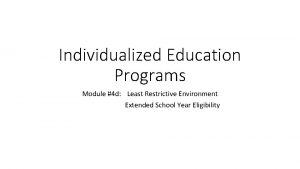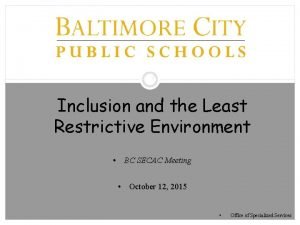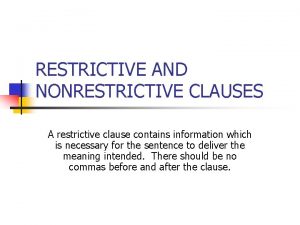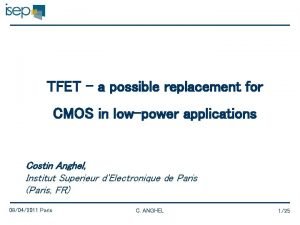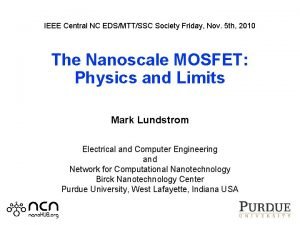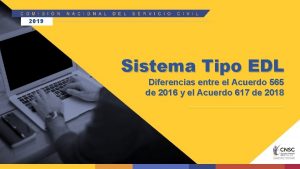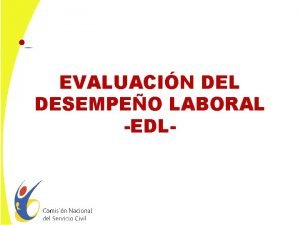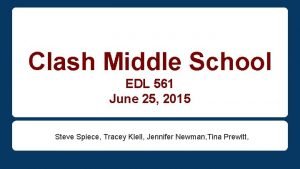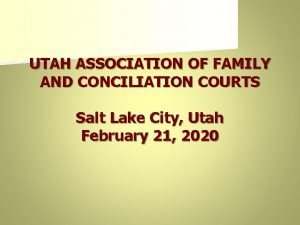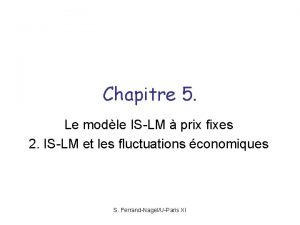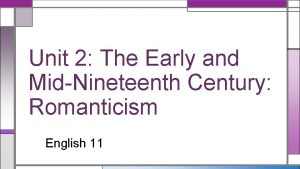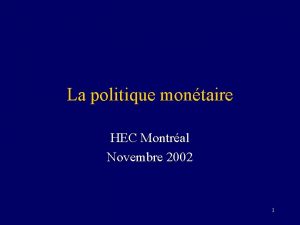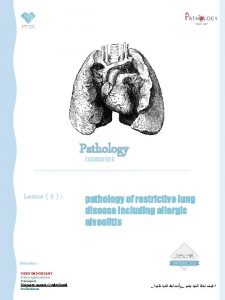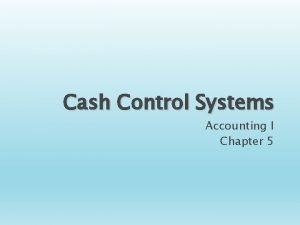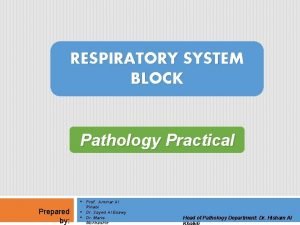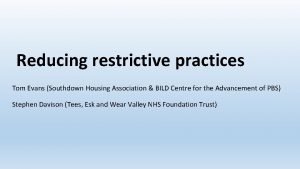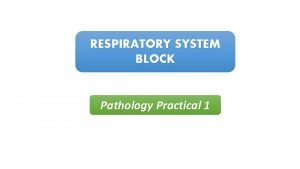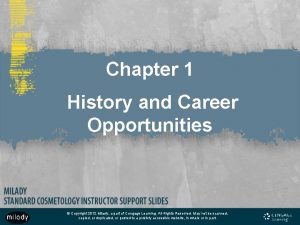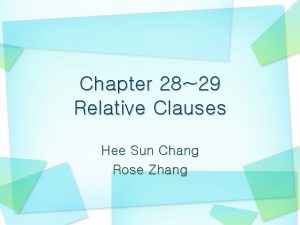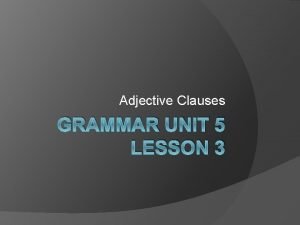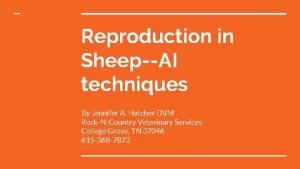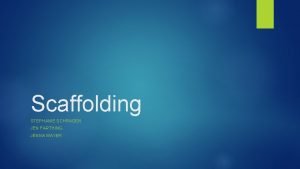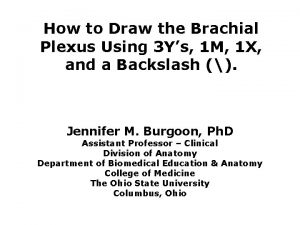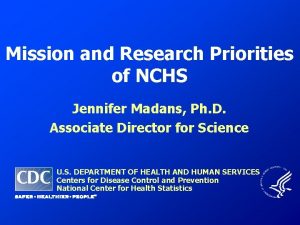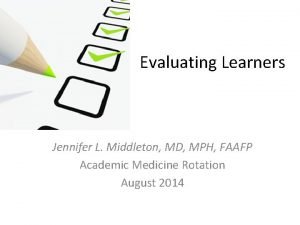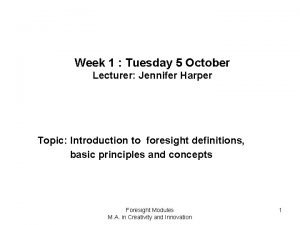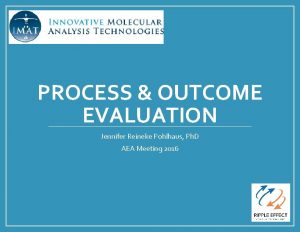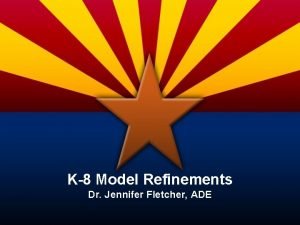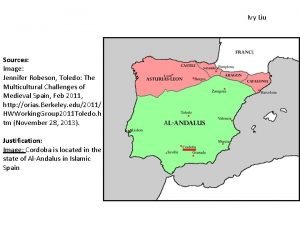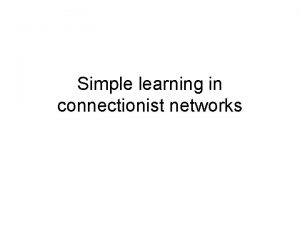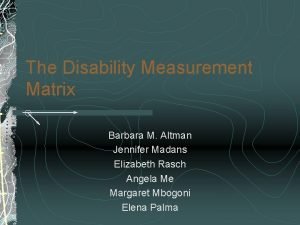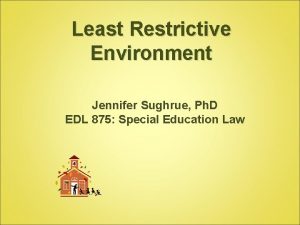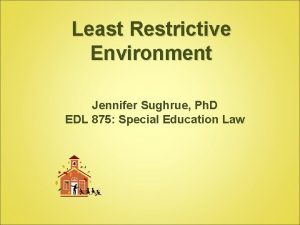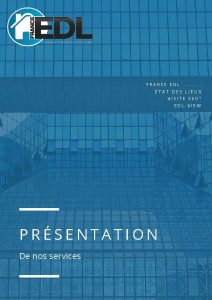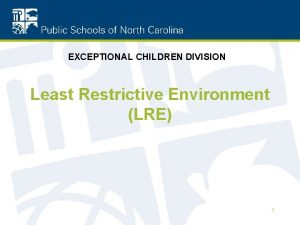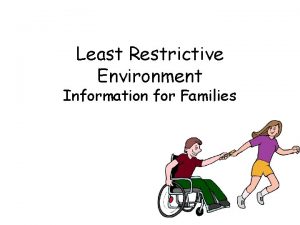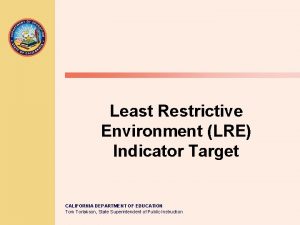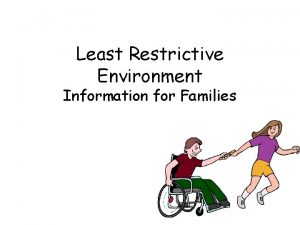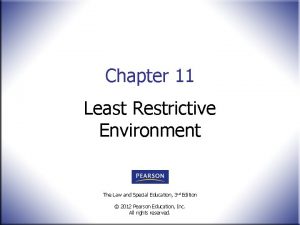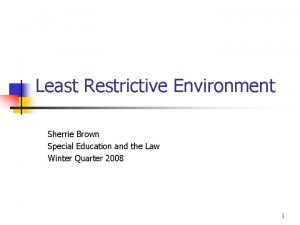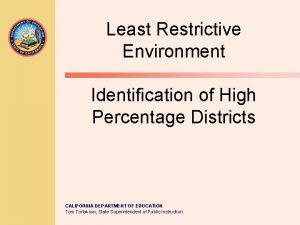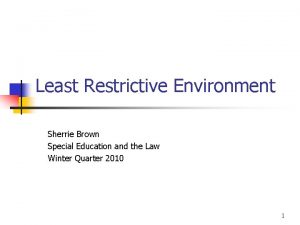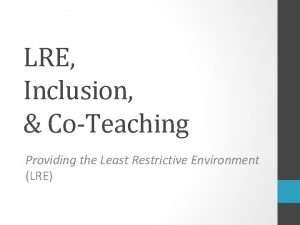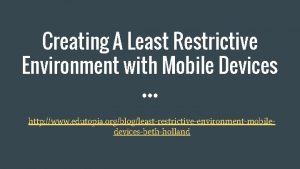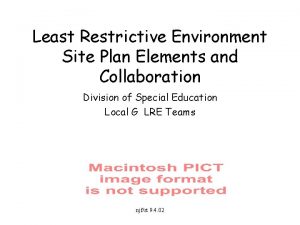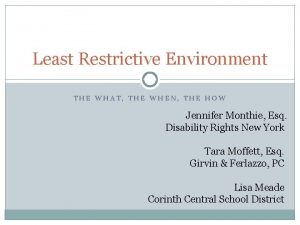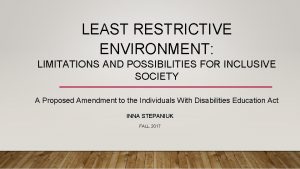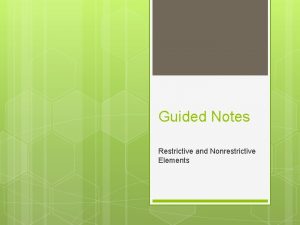Least Restrictive Environment Jennifer Sughrue Ph D EDL






















































- Slides: 54

Least Restrictive Environment Jennifer Sughrue, Ph. D EDL 875: Special Education Law

Underlying Principle of IDEA To bring children with disabilities into the mainstream of life and out of the isolation that often accompanies a disabling condition [A]s much as any other action of Congress in the two hundred years of the Republic, the Education for All Handicapped Children Act represents a gallant and determined effort to terminate the two-tiered invisibility once and for all with respect to exceptional children in the Nation’s school systems. (Robert T. Stafford, as cited in Weber et al. , p. 261) 2

What This Module Covers l Defining Least Restrictive Environment (LRE) > > l Requirements (34 C. F. R. § 300. 114) Continuum of alternative placements (34 C. F. R. § 300. 115) Placements 34 C. F. R. (§ 300. 116) Nonacademic settings (34 C. F. R. § 300. 117) Role of “Supplementary Aids and Services” in Supporting Participation of Children with Disabilities l Factors to Consider in LRE Decision Making l Case Law in Determining LRE l Reverse Mainstreaming l Role of the Administrator in Ensuring LRE 3

Defining LRE Each public agency must ensure that— • To the maximum extent appropriate, children with disabilities are educated with children who are nondisabled and… 34 C. F. R. § 300. 114 LRE requirements 4

Defining LRE Special classes, separate schooling, or other removal of children with disabilities from the regular educational environment occurs only… …if the nature or severity of the disability is such that education in regular classes with the use of supplementary aids and services cannot be achieved satisfactorily 5

Defining LRE As the Department explained in the Analysis of Comments and Changes to the final Part B regulations in the Federal Register: The LRE requirements in §§ 300. 114 through 300. 117 express a strong preference, not a mandate, for educating children with disabilities in regular classes alongside their peers without disabilities. (71 Fed. Reg. 46585) Segregation is permissible the when use of supplementary aids and services in less restrictive settings are not sufficient to provide an appropriate education Full inclusion regardless of the student’s individual needs is not the intent of regulations governing LRE 6

Defining LRE Placement-Neutral Funding States must not use a funding mechanism that distributes funds based on the type of setting in which a child is served, if doing so leads to a violation of LRE requirements Placement decisions must be based on a child’s unique needs and IEP, not on administrative convenience, disability/program label, or allocation of funds 7

Defining LRE Continuum of Alternative Placements Includes providing special education services in. . . General Education Classroom Special Classes <<Less Restrictive Special Day Schools Child’s Home Residential Facilities or Hospitals More Restrictive>> 8

Defining LRE Placement Decisions Placement decisions are made by a group of persons, including the parents, who are knowledgeable about: the child the meaning of the evaluation data • the placement options • • 9

Defining LRE The child’s placement is determined at least annually It is based on the child’s IEP It is as close as possible to the child’s home Unless child’s IEP requires another arrangement, the child is educated in the school s/he would attend if nondisabled 10

Defining LRE Consideration must be given to any potential harmful effect on the child or on the quality of services that s/he needs A child with a disability may not be removed from education in age-appropriate general education classrooms solely because of needed modifications in the general education curriculum 11

Three Circuit Court LRE Tests 1. Roncker v. Walter 700 F. 2 d 1058 (6 th Cir. 1983) Neill Roncker was a 9 -year-old who was severely retarded. • The school district wanted to place Neill in a special county school that was exclusively for children with mental retardation • Parents objected, stating that Neill would benefit from being around non-disabled children at least during recess, lunch, and physical education continued. . . 12

Three Circuit Court LRE Tests The 6 th Circuit determined that the school district must show that it has properly determined what would be the least restrictive environment for a child • Where a segregated setting might provide a better academic program, the court must consider whether those superior services can be provided in a nonsegregated setting with appropriate support and supplementary aids • Only when the benefits of mainstreaming are marginal and outweighed by the benefits afforded by services that cannot be provided in a non-segregated setting is mainstreaming considered appropriate • Roncker test used in the 4 th, 6 th, and 8 th circuits 13

Three Circuit Court LRE Tests 2. Daniel R. R. v. State Bd. of Educ. 874 F. 2 d 1035 (5 th Cir. 1989) Daniel R. , a 6 -year-old with Downs Syndrome • Daniel was in a special education early childhood program, but parents wanted him to also have exposure to non-disabled children by also attending a half-day regular Pre-kindergarten class • After a short period of time, the placement to include him in a regular Pre-K class was changed because school determined he could not benefit from the curriculum, even with substantial changes, and • He was disruptive, requiring most of the teacher’s time, which was to the determinant of the other children continued. . . 14

Three Circuit Court LRE Tests • IEP team removed Daniel from the general education Pre-K classroom and continued his half day placement in the special classroom • The IEP allowed for Daniel to have lunch in the cafeteria with all children if his mother was there to supervise him • He would also have recess with non-disabled children • Parents disagreed with the changes and proceeded with their right to due process to have the IEP reviewed • The hearing officer and district court ruled in favor of the school district • Parents appealed to the 5 th Circuit Court of Appeals continued. . . 15

Three Circuit Court LRE Tests The 5 th Circuit chose not to apply the 6 th Circuit’s Roncker test, opting to develop its own 1. The first question to ask is, can meaningful education be provided in the general education classroom with supplementary aids and services? a. Statute requires more than token effort, but the requirement is not limitless • Does not require general education teacher to devote most or her/his time to one special education student • Does not require curriculum to be modified to the point that it no longer has any relationship to the general education curriculum continued. . . 16

Three Circuit Court LRE Tests The 5 th Circuit developed its own. . . 1. Can meaningful education be provided. . . b. c. 2. Meaningful education benefit is not limited to only curricular benefits; child can learn from non-disabled peers Look at the effect the special education child’ presence is having on the learning environment If it is determined that education cannot be achieved satisfactorily in the general education classroom, the second question is, has the children been mainstreamed to the maximum extent appropriate? a. Placement is along a continuum, with an appropriate mix of general education settings, special education settings, and non-academic settings. continued. . . 17

Three Circuit Court LRE Tests The 5 th Circuit developed its own. . . 2. Has the children been mainstreamed to the maximum extent appropriate? b. Placement should be reviewed year-to-year Applying its two-pronged test, the court determined that the school district had met its burden in demonstrating that it was providing FAPE in the least restrictive environment for Daniel. The Daniel R. test is also used in 3 rd and 11 th circuits 18

Three Circuit Court LRE Tests 3. Sacramento Unified School District v. Rachel H. 14 F. 3 d 1398 (9 th Cir. 1994) Rachel, 11 years old and mentally disabled with an I. Q. of 44 • Had been in special classes fulltime for four years • Parents wanted her to be in general education classes fulltime, but school district refused • Rachel’s parents moved her to a private school where she was in general education classes and filed a due process complaint • Both the hearing officer and federal district court ruled against the school district continued. . . 19

Three Circuit Court LRE Tests The 9 th Circuit approved and adopted the four-factor balancing test the district court developed, taken from reasoning in both the Roncker and Daniel R. tests What are the educational benefits of fulltime placement in the general education classroom with supplementary aids and services relative to a more segregated setting? 2. What are the non-academic benefits of the general education classroom? 3. What effect does the student’s presence have on others in the general education classroom? 4. What is the cost associated with provision of supplementary services and aids in the general education classroom? 1. continued. . . 20

Three Circuit Court LRE Tests The 9 th Circuit affirmed the lower court’s ruling 1. Educational benefit • • 2. The school district failed to provide evidence that the educational benefits Rachel would receive were equal to or better in the segregated setting than the general education setting Rachel’s teacher at the private school and expert witnesses testified to Rachel’s progress in the general education classroom Non-academic benefits • Evidence of Rachel’s improved communication and social skills as well as her self-confidence continued. . . 21

Three Circuit Court LRE Tests The 9 th Circuit affirmed the lower court’s ruling. . . 3. Effect on others in the classroom • • 4. Both parties agreed that Rachel was not a disruption in the class Rachel’s current teacher testified that Rachel did not interfere with her ability to teach the other students Cost of mainstreaming Rachel • The court believed the school district inflated the cost of educating Rachel in the regular classroom 22

A Lesser Known Test Hartmann v. Loudoun County Board of Education 118 F. 3 d 996 (4 th Cir. 1997) The 4 th Circuit had previously applied the Roncker test to LRE cases, but it returned to a three-prong test it developed in a 1989 case, Devries v. Fairfax County School Board, * for the purpose of analyzing the Hartmann controversy. * 882 F. 2 d 876 (4 th Cir. 1989) 23

A Lesser Known Test Mark, an 11 -year-old autistic boy • Prior to moving to Virginia, Mark had been educated in a general education first grade classroom in Illinois with a fulltime aide and supplementary services • In Loudoun County, Mark was placed in a general education classroom selected for various factors that favored his placement • Chose a strong teacher and a smaller classroom with more independent children • All personnel who had contact with Mark were given specific training in autism • Fulltime aide was trained in facilitated communication • He continued to receive related services and other supports continued. . 24.

A Lesser Known Test Mark, an 11 -year-old autistic boy • By the end of the year, Mark’s IEP team determined he was not making academic progress • Recommended he be placed in a class specifically designed for autistic children at another school • Parents refused to consent, arguing that he should be able to remain in the general education classroom so that he would be educated with non-disabled students • They filed a due process claim, during which time Mark remained in the regular classroom for the first semester of 3 rd grade continued. . . 25

A Lesser Known Test Mark, an 11 -year-old autistic boy • The local and state hearing officers both ruled in favor of the school district • Parents moved to Montgomery County, where Mark was enrolled in a 3 rd grade general education classroom • They filed suit in federal district court, which overturned the two hearing officers’ decisions • The 4 th Circuit chastised the district court for not giving the administrative record its due weight and for substituting its own judgment for that of the professional educators continued. . . 26

A Lesser Known Test • The 4 th Circuit noted that the district court had ignored the 4 th Circuit’s three principles on LRE it had articulated in the De. Vries case • In De. Vries, the 4 th Circuit ruled that mainstreaming is not required where the child with disabilities would not receive educational benefit from mainstreaming into a general education class 2. any marginal benefit from mainstreaming would be significantly outweighed by the benefits which could be feasibly obtained only in a more segregated setting, or 3. the student is a disruptive force in the general education classroom 1. continued. . . 27

A Lesser Known Test • Applying these standards to the Hartmann case, the 4 th Circuit overturned the district court decision • It is believed that this, now referred to as the Hartmann test, may be the test the 4 th Circuit will continue to use, but it has used the Roncker test previously. 28

Reverse Mainstreaming Reverse mainstreaming is a method to provide opportunities for students with disabilities to be educated with non-disabled peers, but yet in a segregated setting 29

Reverse Mainstreaming In mainstreaming, a student with disabilities is placed in a general education classroom with non-disabled students for some or all classes • In reverse mainstreaming, general education students are placed in a special education setting for a few hours or a full day • Most commonly used in pre-school and kindergarten classes, but not exclusively 30

Reverse Mainstreaming Beth v. Van Clay 282 F. 3 d 493 (7 th Cir. 2002) Beth, a 13 -year-old student with severe mental and physical disabilities 1. Educated in her neighborhood school and in general education classrooms for 7 years, but the middle school curriculum and schedule, which required her to change classes six times daily, was proving to be too challenging 2. At the annual IEP meeting, the school district recommended Beth be placed in a special education program (ELS) in a neighboring school district continued. . . 31

Reverse Mainstreaming 3. The ELS classes had only 5 or 6 students per class, with one-on-one student –teacher ratio The students were mainstreamed into the general education classrooms for all non-academic classes and some social studies and science classes Also went on field trips, attended assemblies, and had lunch and recess with the general education students Reverse mainstreaming was also a part of the program, in which non-disabled students came into the ELS classrooms to interact with the ELS students continued. . . 32

Reverse Mainstreaming 4. The court dismissed the parents’ argument that any benefit is sufficient reason to keep Beth in the general education classroom The ELS program outlined for Beth was calculated to provide educational and functional benefit and to provide her an education with her non-disabled peers to the greatest extent appropriate The court made specific note of the reverse mainstreaming provision in the ELS program 33

Reverse Mainstreaming T. R. v. Kingwood Township Board of Education 205 F. 3 d 572 (3 rd Cir. 2000) In an earlier case, the 3 rd Circuit ruled that a reverse mainstreamed classroom may not be the least restrictive environment for a child with disabilities if another less restrictive setting is available within a reasonable distance from the neighborhood school 34

Reverse Mainstreaming T. R. v. Kingwood Township Board of Education 205 F. 3 d 572 (3 rd Cir. 2000) N. R. was a pre-school child with disabilities 1. When he turned 5 years old, the school district determined that he could enter the general education kindergarten class Parents said no, preferring to give him one more year in pre -school The only pre-school class available in Kingwood Township was a half-day class composed of 50% children with disabilities and 50% non-disabled children N. R. would have spent the other half day in a segregated resource room setting 35

Reverse Mainstreaming 2. Parents rejected this IEP and opted to place N. R. in a private day-care facility They sought to be reimbursed for tuition and to have supplementary aids and services provided there The day care center was not an accredited pre-school 3. The 3 rd Circuit ruled that the district court had a. appropriately determined that the IEP offered by Kingwood Township would confer meaningful educational benefit , but b. did not adequately consider potential alternative settings that would have been less restrictive than the reverse mainstream class Kingwood offered 36

Reverse Mainstreaming 4. Noted that Kingwood’s pre-school program was not “typical” inasmuch as it was neither a general education class nor a special education class, but it was nonetheless more restrictive than a “regular, fully mainstreamed preschool class would be” (p. 579). a. The reverse mainstreamed class would only be appropriate if 1) education in a general education classroom could not be achieved, even with supplementary aids and services or 2) a general education classroom is not available within reasonable commuting distance of the child continued. . . 37

Reverse Mainstreaming b. N. R. could be educated in the general education classroom, as evinced by the kindergarten IEP originally offered N. R and there was no evidence that he would have been disruptive c. A school district is not required to start a program for one child, but it is “required to take into account a continuum of possible alternative placement options when formulating an IEP, including ‘placing children with disabilities in private school programs for nondisabled preschool children. ’” 34 C. F. R. § 300. 552 d. The circuit court agreed with district court that the day care center did not qualify for consideration, but it did remand the case back for consideration of other possible alternatives 38

Summary of Standards for Determining LRE Analysis of LRE is fact specific, with a statutory presumption for mainstreaming Must be based on student’s individual needs Must weigh benefits (educational and social) of the general education setting with those provided in a segregated setting Must consider impact of student’s presence on others in the general education classroom 39

Summary of Standards for Determining LRE Must involve good faith effort to included child with disabilities in the general education setting with appropriate supplementary aids and services Must consider provision of FAPE over integration 40

Model for Determining LRE* Step 1: Determine eligibility Step 2: Define what constitutes appropriate educational services Step 3: Determine if services can be provided in the general education setting in its current form Step 4: If not, determine if services can be provided in the general education setting if it is modified *Champagne, as cited in Yell, p. 288 41

Model for Determining LRE Step 5: If not, determine at what point along the continuum of placements that services can be provided Step 6: If not, determine at what point along the continuum of placements that services can be provided, striving for the least restrictive given the circumstances 42

Model for Determining LRE Step 7: Determine if there are opportunities for integration in the general education classroom during the school day 43

Non-Academic LRE Participation in Extracurricular and Nonacademic Services and Activities Recess Transportation Clubs Meals 44

Non-Academic LRE Athletics 45

Non-Academic LRE Participation in Extracurricular and Nonacademic Services and Activities Each school district must ensure that. . . the student has supplementary aids and services determined appropriate and necessary by the student’s IEP team to participate in nonacademic and extracurricular services and activities 46

In Other Words Special education is not a place. It is a set of services and supports Where a student with disabilities receives special education services is that student’s placement 47

The Role of the Administrator Three Primary Roles: 1. Develop a climate that supports LRE 2. Establish organizational structures needed to implement LRE 3. Provide effective supervision and support of LRE 48

The Role of the Administrator Underlying Principles: Administrators need to ensure. . . 1. A continuum of services; 2. Instruction in general education classrooms; 3. Access and progress in general education curriculum; and 4. Instructional, curricular, and behavioral supports layered within this environment. 49

The Role of the Administrator Integration of Students with Disabilities Administrators will ensure that. . . 1. Students attend their home school 2. Students participate in general education instructions and classrooms with use of collaborative services and supports 3. Positive behavioral supports and interventions are provided 50

The Role of the Administrator Access to General Curriculum & Standards for Academic Achievement Administrators will ensure that students. . . • Participate in Statewide assessments; • Progress in the general education curriculum; • Graduation or complete high school; • Stay in school; and • Transition to adult living. 51

The Role of the Administrator Organization and Structure Administrators will. . . • Implement needs-based programming • Identify available supports • Match supports to students • Provide common planning time • Build the capacity of the school to support a variety of students 52

References Alexander, K. , & Alexander, M. D. (2012). American public school law (8 th ed. ). Belmont, CA: Wadsworth. Brown, P. E. (2012). Educating students with disabilities, § 6: 6. Least restrictive environment. 2 Education Law § 6: 6. Los Angles Unified Sch. Dist. , Div. of Special Education. (2004). Least restrictive environment: What an administrator needs to know. Retrieved from http: //sped. lausd. net/sepg 2 s/pg 2_staff_pre. htm 53

References National Dissemination Center for Children with Disabilities (NICHCY). LRE decision making. Retrieved from http: //nichcy. org/laws/idea/legacy/module 15 Weber, M. C. , Mawdsley, R. , & Redfield, S. (2010). Special education law: Cases and materials (3 rd ed. ). New Providence, NJ: Lexis. Nexis. Yell, M. L. (2011). The law and special education (3 rd ed. ). Upper Saddle River, NJ: Pearson Education, Inc. 54
 Lre justification statement examples
Lre justification statement examples Least restrictive environment examples
Least restrictive environment examples Define least restrictive environment
Define least restrictive environment Non restrictive relative clause
Non restrictive relative clause Emotional barriers
Emotional barriers Ieee edl
Ieee edl Edl authentication
Edl authentication Ieee edl
Ieee edl Edl 2019
Edl 2019 Edl files
Edl files Compromisos comportamentales edl
Compromisos comportamentales edl Edl positive school culture & climate
Edl positive school culture & climate Financial environment of business
Financial environment of business Family facilitator guide utah
Family facilitator guide utah Difference between obstructive and restrictive lung disease
Difference between obstructive and restrictive lung disease Bronchodilator test positive
Bronchodilator test positive Politique monetaire restrictive
Politique monetaire restrictive The early and mid-nineteenth century romanticism
The early and mid-nineteenth century romanticism Difference between obstructive and restrictive lung disease
Difference between obstructive and restrictive lung disease Nonrestrictive clauses
Nonrestrictive clauses Politique monetaire restrictive
Politique monetaire restrictive Restrictive lung disease
Restrictive lung disease Restrictive lung disease
Restrictive lung disease Cash control systems
Cash control systems Copd means
Copd means Restrictive and nonrestrictive adjective clauses
Restrictive and nonrestrictive adjective clauses Asbestos pleural plaques
Asbestos pleural plaques Terminology relating to restrictive practice
Terminology relating to restrictive practice Reduced relative clause example
Reduced relative clause example Restrictive adjective clause
Restrictive adjective clause Bronchopneumonia and lobar pneumonia
Bronchopneumonia and lobar pneumonia Restrictive lung disease
Restrictive lung disease Dr philip kiely
Dr philip kiely During which austere and restrictive period
During which austere and restrictive period Relative pronouns rules
Relative pronouns rules Restrictive clause definition
Restrictive clause definition Jennifer pae
Jennifer pae Jennifer hatcher vet
Jennifer hatcher vet Jennifer dembski
Jennifer dembski Jennifer farthing
Jennifer farthing How to draw brachial plexus
How to draw brachial plexus Jennifer bruton
Jennifer bruton Jennifer erle
Jennifer erle Jennifer madans
Jennifer madans Jennifer middleton md
Jennifer middleton md Jennifer harper-lee
Jennifer harper-lee Jennifer aniston
Jennifer aniston Jennifer reineke
Jennifer reineke Dr jennifer fletcher
Dr jennifer fletcher Daniel liu toledo
Daniel liu toledo Jennifer lindstrom md
Jennifer lindstrom md Jennifer gress
Jennifer gress Brad pitt
Brad pitt Jennifer madans
Jennifer madans Learn english with jennifer lesson 3
Learn english with jennifer lesson 3
